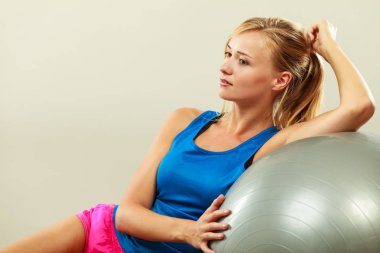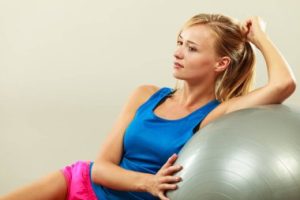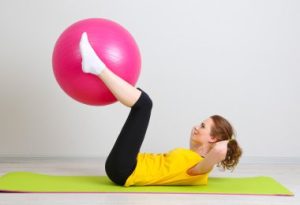
Can Exercise Make Your Period Heavier (7 Important Facts)
Can exercise make your period heavier? This question often arises among women who are integrating fitness routines into their lives. While exercise is generally beneficial for overall health, its impact on menstrual flow can vary, with some experiencing changes in the intensity and duration of their periods.
Exercise is often celebrated as a universal remedy for numerous health woes, but what if this beloved activity had an unexpected twist? Imagine your dedication to staying fit not only sculpting your physique but also potentially intensifying your menstrual flow. Yes, the sweat-inducing, heart-pumping routines that boost your endorphins might also be affecting the heaviness of your period. This surprising intersection of fitness and female health opens up a compelling dialogue about how your body respond to the rhythms of exercise and menstruation, challenging us to rethink the impact of your workout habits on your cycles.

Can Exercise Make Your Period Heavier
Yes, exercise can influence your menstrual cycle, and in some cases, it might make your period heavier. However, this isn’t a universal experience and can vary from person to person. The intensity, duration, and type of exercise all play a role in how your body responds. While some women may notice heavier bleeding, others might experience lighter periods or no change at all. Understanding how exercise affects menstruation can help you manage your workouts better.
How Exercise Affects Menstrual Flow
Exercise is a key factor in overall health and can significantly impact your menstrual cycle. Regular physical activity improves circulation, which can sometimes lead to heavier menstrual flow. High-intensity workouts, such as running, weightlifting, or HIIT, increase blood flow throughout the body, including the pelvic area.
This increased circulation can cause more blood to be shed during your period. Additionally, strenuous exercise can lead to hormonal fluctuations, particularly in estrogen and progesterone, which can further influence the heaviness of your menstrual bleeding. It’s also important to consider that sudden changes in exercise routines can shock the body, potentially causing irregularities in your cycle, including heavier periods.
Hormonal Fluctuations and Menstrual Changes
Hormonal balance is crucial in regulating menstrual cycles. Intense physical activity can disrupt the normal hormonal balance, leading to changes in menstrual flow. For example, excessive exercise can decrease body fat percentage, impacting estrogen levels since fat cells produce this hormone.
Low estrogen levels can sometimes lead to irregular or missed periods, but in some cases, they can also cause the body to react by increasing menstrual flow when the period does occur. It’s a delicate balance, and each woman’s body responds differently based on her unique hormonal makeup and fitness regimen.
Stress and Menstrual Irregularities
Exercise is a form of physical stress, and while it has numerous health benefits, it can also contribute to the body’s overall stress levels. High stress, whether physical or emotional, can affect the menstrual cycle by increasing the production of cortisol, a stress hormone. Elevated cortisol levels can interfere with the balance of reproductive hormones, potentially leading to heavier periods. This is particularly true for women who engage in intense training or are athletes, as their bodies undergo significant physical stress regularly.
Individual Variability and Exercise Impact
Every woman’s body is different, and the impact of exercise on menstrual flow can vary widely. Factors such as genetics, baseline fitness level, and overall health play significant roles in how exercise affects menstruation. Some women may find that moderate exercise helps regulate their periods and reduce symptoms of PMS, including bloating and cramping. Others may experience increased flow or changes in cycle regularity with intense exercise routines. It’s essential to pay attention to your body and track any changes in your menstrual cycle when adjusting your exercise habits.
Managing Exercise and Menstrual Health
To balance exercise and menstrual health, it’s crucial to listen to your body and adjust your workout intensity and duration as needed. If you notice heavier periods with increased physical activity, consider scaling back or diversifying your workouts to include low-impact exercises like yoga or swimming.
Maintaining a healthy diet and staying hydrated can also help manage menstrual symptoms. Consulting with a healthcare provider can provide personalized advice based on your specific health needs and fitness goals. Understanding the connection between exercise and menstrual health can empower you to make informed decisions about your workout routines and overall well-being.
Physiological Basis of Menstruation
The physiological basis of menstruation is a complex interplay of hormonal regulation, primarily involving estrogen and progesterone, orchestrated through the menstrual cycle’s distinct phases: follicular, ovulatory, luteal, and menstrual. The cycle typically spans about 28 days, starting with the follicular phase, during which the hypothalamus secretes gonadotropin-releasing hormone (GnRH). This stimulates the anterior pituitary gland to release follicle-stimulating hormone (FSH), promoting the growth of ovarian follicles.
These follicles, in turn, produce estrogen, which fosters the thickening of the endometrium, the uterus’s inner lining. Rising estrogen levels eventually trigger a surge in luteinizing hormone (LH) around the midpoint of the cycle, leading to ovulation—the release of a mature egg from the dominant follicle. Following ovulation, the luteal phase begins, characterized by the formation of the corpus luteum from the remnants of the dominant follicle.
The corpus luteum secretes both estrogen and progesterone, with progesterone stabilizing the endometrial lining in preparation for potential implantation of a fertilized egg. If fertilization does not occur, the corpus luteum degenerates, leading to a dramatic drop in both estrogen and progesterone levels. This hormonal decline triggers the breakdown and shedding of the endometrial lining, marking the onset of the menstrual phase. Menstruation is thus the outward manifestation of this cyclical hormonal interplay, involving the systematic preparation and subsequent renewal of the uterine lining, driven by the fluctuations in estrogen and progesterone orchestrated by the hypothalamic-pituitary-ovarian axis.
Effects of Exercise on Hormonal Balance
Influence of physical activity on estrogen and progesterone levels
Exercise has profound effects on hormonal balance, influencing a range of hormones that are crucial for maintaining health and wellbeing. Physical activity can significantly affect estrogen and progesterone levels, which are key hormones in the reproductive system. Regular exercise has been shown to help regulate menstrual cycles by balancing these hormones, potentially reducing symptoms of premenstrual syndrome (PMS) and enhancing fertility. However, excessive exercise can lead to decreased estrogen levels, which may result in menstrual irregularities or amenorrhea, particularly in athletes. This highlights the importance of moderation and individualized exercise programs.
Role of cortisol and other stress hormones
Moreover, exercise impacts cortisol and other stress hormones. Cortisol, known as the stress hormone, can be elevated in response to both physical and psychological stress. Regular, moderate exercise can help reduce baseline cortisol levels, thereby improving stress resilience and overall mental health. Conversely, intense or prolonged physical activity might increase cortisol temporarily, but this is typically followed by a return to normal levels, contributing to the stress-reducing benefits of regular exercise over time.
Impact of endorphins and their potential effects on menstruation
Endorphins, often referred to as “feel-good” hormones, are also significantly influenced by exercise. These neurochemicals, which act as natural painkillers and mood elevators, are released during physical activity, leading to improved mood and a sense of well-being. The release of endorphins through exercise can alleviate stress and anxiety, which may indirectly benefit menstrual health by reducing the overall stress load on the body. Consequently, regular physical activity can help manage menstrual discomfort and improve overall hormonal balance, emphasizing the multifaceted benefits of incorporating exercise into daily routines for hormonal health.

Exercise and Menstrual Flow: Mechanisms and Evidence
How different types of exercise might affect menstrual flow: Intense exercise vs. moderate exercise
Exercise can significantly influence menstrual flow through various mechanisms, depending on the type and intensity of physical activity. Intense exercise, such as endurance training or high-intensity interval workouts, has been linked to alterations in menstrual patterns. This can include changes in the regularity of cycles, as well as modifications in the duration and volume of menstrual bleeding.
The physiological basis lies in the impact of exercise on hormonal balance, particularly cortisol and reproductive hormones like estrogen and progesterone. These hormones play pivotal roles in regulating the menstrual cycle and can be disrupted by strenuous physical activity. In contrast, moderate exercise, such as regular aerobic activities or moderate weight training, tends to have a more stabilizing effect on menstrual cycles for many women, potentially promoting regularity without significant alterations in flow volume.
Potential increase in blood flow due to vascular changes
Vascular changes induced by exercise may also contribute to alterations in menstrual flow. Increased blood flow to muscles and tissues during exercise could theoretically lead to heightened blood supply to the uterus, potentially affecting the shedding process of the endometrial lining. The uterine lining, responsive to hormonal fluctuations, undergoes cyclic changes that culminate in menstruation if conception does not occur.
Intense exercise might disrupt this process by influencing hormone levels, delaying ovulation, or affecting the quality of the endometrium, thereby altering menstrual flow characteristics. Conversely, moderate exercise may support healthier hormonal balance, aiding in the regular shedding of the uterine lining. Overall, while the relationship between exercise and menstrual flow remains complex and multifaceted, understanding these mechanisms can help women make informed decisions about their fitness routines and manage potential menstrual irregularities effectively.
Factors Influencing the Impact of Exercise on Periods
The impact of exercise on menstrual cycles is influenced by several key factors that interact in complex ways. Firstly, the intensity and duration of exercise play crucial roles; high-intensity or prolonged physical activity can affect hormonal balance and potentially disrupt regular menstrual patterns. Individual differences such as age and fitness level also contribute significantly; younger women and those with higher fitness levels may experience different effects compared to older or less fit individuals.
Hormonal balance, influenced by factors beyond exercise such as genetics and overall health, also plays a critical role in menstrual regularity. Diet and nutrition are paramount; inadequate calorie intake or nutrient deficiencies can disrupt hormone production and menstrual cycles.
Moreover, stress levels and overall lifestyle factors including sleep patterns, work-life balance, and mental health can impact the hypothalamic-pituitary-ovarian axis, which regulates the menstrual cycle. Therefore, while exercise is generally beneficial for overall health, its effects on menstruation vary widely and are deeply intertwined with individual physiology and lifestyle choices. Understanding these multifaceted influences is crucial for optimizing women’s health and well-being.

Potential Outcomes of Exercise on Menstrual Health
Scenarios where exercise could lead to heavier periods
Regular exercise can significantly impact menstrual health in various ways, presenting both positive and potentially challenging outcomes. Engaging in consistent physical activity can lead to increased uterine blood flow, promoting a healthier menstrual cycle by facilitating more efficient shedding of the endometrial lining. This can contribute to a regular, moderate flow in many individuals. However, for some, particularly athletes or those who engage in intense training regimens, exercise might trigger heavier periods due to the enhanced blood circulation to the uterus, potentially resulting in more substantial menstrual flow. Moreover, exercise can induce hormonal fluctuations, affecting estrogen and progesterone levels, which might lead to variations in menstrual cycle length and intensity of periods.
Scenarios where exercise might lead to lighter or irregular periods
Excessive exercise or strenuous physical activity can lead to exercise-induced amenorrhea, where menstrual periods become irregular or cease altogether due to hormonal suppression. This condition is often observed in athletes with low body fat percentages or those experiencing high levels of physical stress. Hormonal suppression from intense exercise can disrupt the normal menstrual cycle, causing irregular or lighter periods, or in some cases, a complete absence of menstruation. Therefore, while exercise generally promotes menstrual health by improving blood circulation and hormonal balance, it’s crucial for individuals, especially athletes, to maintain a balanced approach to exercise to ensure optimal menstrual function and overall well-being.
Practical Considerations and Recommendations
Balancing exercise intensity with menstrual health requires a nuanced approach that considers individual variability and the intricate relationship between physical activity and hormonal cycles. Women should aim to engage in a variety of exercises that enhance cardiovascular fitness, strength, and flexibility without overwhelming the body. High-intensity workouts, while beneficial, should be moderated and balanced with adequate rest periods, particularly during phases of the menstrual cycle when the body might be more susceptible to fatigue and injury.
Listening to one’s body is crucial; signs such as irregular periods, excessive fatigue, or changes in menstrual flow can indicate that the exercise regimen may need adjustment. It’s important to recognize these signals as potential red flags and take proactive measures, such as reducing workout intensity, incorporating more recovery days, or switching to lower-impact activities.
Consulting with healthcare providers, such as gynecologists, endocrinologists, or sports medicine specialists, can provide valuable insights tailored to individual health profiles. These professionals can offer personalized recommendations based on a thorough understanding of one’s menstrual health, overall fitness levels, and any underlying health conditions. This collaborative approach ensures that exercise remains a beneficial part of one’s lifestyle without compromising menstrual health.
Additionally, keeping a menstrual diary or using apps to track cycles and symptoms can be an effective tool for monitoring changes and making informed decisions about exercise intensity. By prioritizing both physical fitness and menstrual health, women can achieve a balanced and sustainable approach to exercise.
FAQs About Can Exercise Make Your Period Heavier
Q1. Can exercise make my period heavier?
A. Yes, it is possible. While exercise generally promotes a healthy menstrual cycle, some women may experience heavier periods due to increased physical activity, particularly if the exercise is intense.
Q2. Why might exercise make my period heavier?
A. Intense exercise can lead to hormonal fluctuations, which may affect the menstrual cycle and potentially cause a heavier flow. Changes in body fat percentage and increased blood circulation can also contribute to this.
Q3. Is a heavier period due to exercise something to worry about?
A. Not necessarily. A heavier period can be a normal response to changes in your exercise routine. However, if you experience significant discomfort, extreme changes, or other unusual symptoms, it’s best to consult with a healthcare provider.
Q4. What types of exercise are most likely to affect my menstrual flow?
A. High-intensity activities such as running, weightlifting, and competitive sports are more likely to influence your menstrual cycle compared to moderate activities like walking or yoga.
Q5. How can I manage a heavier period if it’s due to exercise?
A. You can manage a heavier period by using higher absorbency menstrual products, staying hydrated, and ensuring you get enough rest. Tracking your cycle can also help you prepare for any changes in flow.
Q6. Can all women experience heavier periods due to exercise?
A. No, not all women will experience heavier periods from exercise. Each body reacts differently, and some women may not notice any change in their menstrual flow with increased physical activity.
Q7. Should I stop exercising if my period becomes heavier?
A. You don’t necessarily need to stop exercising. Instead, consider modifying the intensity and type of exercise to see if that helps. It’s important to listen to your body and adjust your routine accordingly.
Q8. Are there any benefits to exercising during my period?
A. Yes, exercising during your period can help alleviate menstrual cramps, reduce bloating, and improve mood through the release of endorphins. It can also promote overall menstrual health.
Q9. Can other factors combined with exercise affect my menstrual flow?
A. Yes, factors such as diet, stress levels, and overall health can also influence menstrual flow. It’s important to consider these factors alongside your exercise routine.
Q10. When should I see a doctor about changes in my menstrual flow due to exercise?
A. If you experience excessively heavy bleeding (soaking through a pad or tampon every hour for several hours), severe pain, or if your menstrual cycle becomes very irregular, it’s advisable to seek medical advice.
Q11. Can a regular exercise routine regulate my menstrual cycle?
A. Regular, moderate exercise can help regulate your menstrual cycle by maintaining a healthy weight and reducing stress, which can both positively influence hormonal balance.
Q12. Is there a specific type of exercise that’s best for menstrual health?
A. Activities such as yoga, Pilates, and moderate cardio can be beneficial for menstrual health. These exercises help maintain overall well-being without putting excessive stress on the body.
Conclusion
In conclusion, exercise generally does not make your period heavier. While vigorous physical activity can influence menstrual cycles by affecting hormone levels, for most women, regular moderate exercise is beneficial and can help alleviate menstrual symptoms, including cramps and mood swings.
Some individuals may experience variations in their flow due to the stress placed on the body by intense workouts or rapid weight loss, but these instances are exceptions rather than the rule. Overall, maintaining a balanced exercise routine supports overall reproductive health and can lead to more regular and manageable menstrual cycles. If significant changes in menstrual flow are observed, it is advisable to consult a healthcare professional to rule out any underlying conditions.